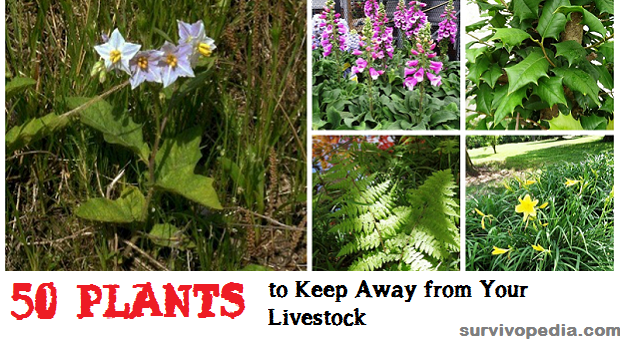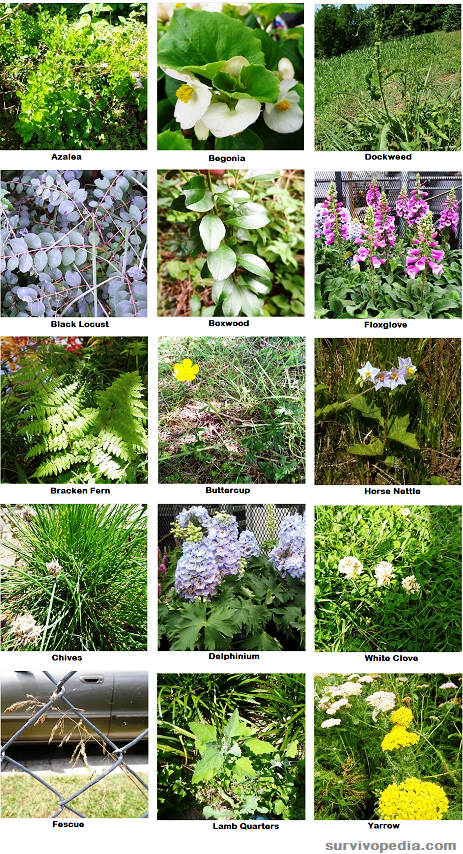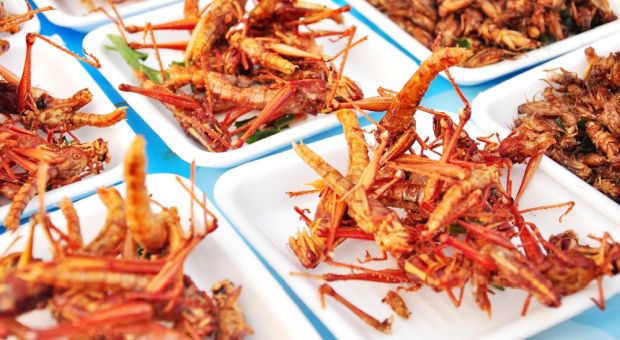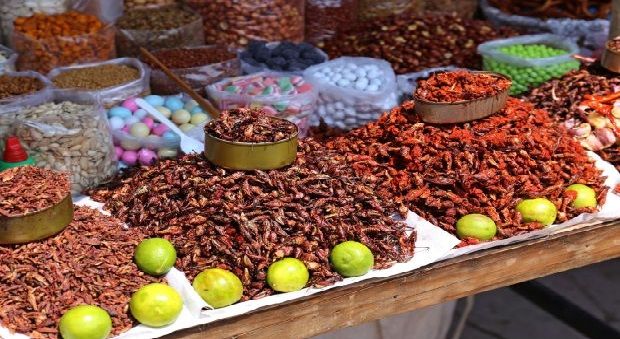Once you buy enough land to support a survival farm and choose the kinds of animals that will live on it, you will still have a long way to go before creating a viable and sustainable farm. Unfortunately, many people that create survival farms fail to realize that toxic plants can easily wipe out all animals on the farm, or make milk and other products inedible.
In order to prevent this from happening, you should be aware of plants that are poisonous or harmful to animals you plan on keeping as well as make sure you understand how they get introduced into your grazing areas.
Common Ways Toxic Plants Get Introduced to Grazing Areas
Surprisingly enough, some of the most toxic plants to livestock come straight from the nursery. This includes herbs, flowers, fruits, and even vegetables that you may decide to grow for food, medicine, or landscaping purposes.
If you visit the local plant nursery, you are sure to be surprised to find many plants and seeds are available for vegetation that does not naturally grow in your area. Some natural perennials may grow as annuals or biennials in your area.
In other situations, the plants you buy may actually turn into an invasive species.
No matter how long these plants grow in your area, they will still be poisonous to livestock. See below the list of the most common 50 plants to avoid when feeding your farm animals, in order to keep them healthy and safe.
Securing Grazing Land from Toxic Plants
If you are determined to grow these plants, then be sure they will be located in an area where livestock cannot get to them.
In addition, some plants have pollen that can contaminate water and other resources. This exposure can be fatal to sensitive animals without you even realizing where the problem came from.
Therefore, you may want to isolate these plants in a greenhouse or take other measures to prevent these plants from coming into contact with livestock.
Keeping Grazing Areas Free of Toxic Plants
Aside from avoiding plants that may harm livestock, there are many native plants or weeds that will need to be removed from grazing areas. You can use a combination of four methods to eliminate toxic plants from pastures:
- Use herbicides that will not harm livestock. Most commercial herbicides will only get rid of specific species of plants. You can just as easily use a mixture of vinegar and dish detergent on a hot sunny day and spray it just on plants to be eliminated.
- Manually uproot plants and burn them in an area where smoke filled with plant oils will not get near livestock or human living areas.
- Look for plant species that will crowd out poisonous plants or prevent them from thriving. Essentially this is the opposite of companion planting for your garden.
- Make the soil as inhospitable as possible to poison plants by altering the pH or other methods. Just be sure that grass or other intended pasture plants can grow in the area and provide proper nutrition for livestock.
Symptoms of Poisoning in Livestock by Most Common Toxin Types and Treatment
No matter how hard you try, there are going to be a few poisonous plants that slip into pasture lands. In most cases, the animal may be sick for several days before making a full recovery.
Unfortunately, there are also some plants that are so toxic just a few berries or leaves will kill an animal within hours.
It is very important to realize that the following emergency treatment methods may still fail even if the animal does not look very sick. The amount of toxin consumed, emptiness or fullness of stomach at time of ingestion, and many other factors will contribute to success or failure of treatment.
The emergency treatments in the following chart is based on the general class of poison. Many plants have specific toxins within each category that may require additional or specialized treatment. But there are hundreds of poisonous plants and also hundreds of chemicals that are well beyond discussion here. You can contact poison control centers and find out more about specific treatments if you so choose.
That being said, in a crisis situation these resources may not be available. In that case, perhaps it can be said that trying these generalized remedies is better than not trying anything at all.
In order to determine which plant poisoned livestock, you can look at material vomited for bits of plant material, take note of breath odor, and also look in the area for plants with signs of chewing on them.
Toxins, Symptoms and Basic Treatments
Alkaloid
- Symptoms of poisoning: Diarrhea, vomit, weakness, collapse, fever, confusion, muscle twitching, apparent blindness, nervous walking, drooling.
- Basic treatment: Alkaloid poisoning can occur over a period of days or more quickly depending on amount consumed. It is best to isolate the animal and see if it recovers; however it will usually be more prone to disease and stunted growth. For scopolamine and atropine poisoning, try giving vinegar orally since it is an acid that can help lower pH.
Glycoalkoid
- Symptoms of poisoning: Vomit, diarrhea, dizziness, dilated pupils, paralysis, fever, hypothermia.
- Basic treatment: If animal has diarrhea, allow to continue until toxin is flushed out. Watch for dehydration and try to prevent. If no diarrhea, try to induce vomiting as a last resort.
Glycoside
- Symptoms of poisoning: Muscle tremors, seizures, rapid breathing, vomiting, diarrhea, colic.
- Basic treatment: Some poisons in this class can kill in minutes and with very little exposure. For cattle and horses, feed activated charcoal at 2 grams per 2 -3 kg of body weight (or some say 1 – 3 grams per kg). The charcoal will absorb any poison that has not yet gotten into the bloodstream. Induce vomiting in species where vomiting is possible.
Lecitin
- Symptoms of poisoning: Panting, rapid heartbeat, bright red mucus membranes. In later stages, mucus membranes and skin will turn pale and temperature decreases
- Basic treatment: Epinephrine injection if available – you will need to find out how much to use based on animal’s weight. Administer IV fluids to keep blood pressure up
Mycotoxin
- Symptoms of poisoning: Lack of appetite, dark stool, low milk production, increased risk of infections. Short term symptoms include vomit, tremors, weakness, fever, increased heart rate, dehydration, seizure.
- Basic treatment: Eliminate moldy foods from feeding areas, prevent grazing in pastures where mold or fungi are present. Induce vomiting if appropriate for species, then administer activated charcoal. Use anti-seizure medication if available based on animal weight. IV fluids may also help if animal is in shock.
Nitrates
- Symptoms of poisoning: Trembling, rapid breathing, difficulty walking or moving. If the poisoning is over long periods of time, cattle may abort, also poor growth and low milk production. To avoid nitrate poisoning in usually safe plants, do not use ammonium sulfate or urea (usually derived from urine) as a fertilizer source.
- Basic treatment: Isolate animal from foods that may contain nitrates. Administer Methylene Blue (usually available in tropical fish supply stores) via IV. It may require several doses. Methylene Blue is very irritating to skin; so cannot be administered orally. Note – these animals may no longer be fit for human consumption.
Oxalates
- Symptoms of poisoning: Mouth pain, swollen tongue or lips, increased salivation, throat swelling, drooling.
- Basic treatment: Keep airway open, use antihistamines if available and safe for species being treated.
Phenols
- Symptoms of poisoning: Burns around or in mouth, vomit, diarrhea, seizures, and sweating, rapid heartbeat.
- Basic treatment: Make sure you are wearing garments and gloves that reduce risk of exposure to phenols since they are easily absorbed through skin and via air. Try to induce vomit and then administer activated charcoal to absorb any poison remaining. If possible, intubate the animal and use CPR for animals. Usually there is no cure for phenol poisoning.
When it comes to raising animals on a farm, many people do not realize how many toxic plants exist in nature, let alone ones that can be introduced to satisfy other interests. In addition, the types of poisons and their treatment can be very complicated.
That said, if you notice an animal with symptoms of poisoning, you can try a few things to keep the animal alive and help it to recover.













David webster | July 2, 2014
|
COWS CANNOT EAT ALFALFA OR RED AND WHILE CLOVER??? YOU GOT SOMETHING SCREWED UP HERE!
Nancy | July 2, 2014
|
Same question I immediately have – this is crazy.
carmela tyrrell | July 2, 2014
|
David,
It surprised me too. However, Alfalfa and clover both cause bloating.
http://www.gov.mb.ca/agriculture/livestock/production/beef/prevention-of-pasture-bloat-in-cattle-grazing-alfalfa.html
http://beefmagazine.com/health/vets-opinion/0601-preventing-pasture-bloat
Allen | November 19, 2016
|
My family has farmed for over 125 years. Some of this information is garbage. You just have to watch how much clover and alfalfa you feed your cattle. If your hayland is grown with a low percentage of alfalfa, all is well. Clover will cause a type of poisoning in cattle if harvested too early in the season. Fescue is one of the best foods for cattle so I have no idea why its on this list. Alfalfa will not cause bloat in horses . Mustard will cause a type of bloat or poisoning but only if ingested by cattle when there is frost on the mature plants (still unsure as to the reasoning behind this). You really should get your information from farmers and ranchers rather than getting it from college people.
MAxine | November 24, 2017
|
Thank you Very much for the information.
If ever you have time to create a blog or a paper about this topic.
I highly appreciate it and ask for it as one of my sources.
I’m currently a college student taking architecture, and my final thesis paper is about building..a small farm school…
so I need a list of plants that are not poisonous to livestock
Great Grey | July 3, 2014
|
Yes, as green plants they can kill, especially early in a cold spring as the plants don’t absorb some of minerals very well when the ground is cold. A lack of magnesium in livestock’s diet is the main cause of death, and a magnesium shot if given soon enough will save them. As hay they are not a problem.
Alan byers | July 2, 2014
|
Alfalfa n clover are a cattle staple , why are they on the list?
carmela tyrrell | July 2, 2014
|
See above for my response to David’s comment.
Also – with regard to clover, the damaging agent is a nitrate. I have a suspicion that clover is listed because of pastures here ntirate containing fertilizers are used and consuming smaller amounts leads to more bloat and other mischief.
C. Kim Chapman | July 2, 2014
|
I don’t know who put you list together, but they obviously haven’t raised many animals or got the table off some “out there” web post. I am an animal scientist and teach animal husbandry, risk management and emergency preparedness to farmers and ranchers. Many of the plants can cause digestive upset and even death, but many others don’t unless the animals are improperly managed. For example, alfalfa or lucerne, can be a problem to cattle and sheep when green and growing as it can cause bloat. However, it can be grazed if a supplement mineral block containing a bloat guard product is fed with it and the animals aren’t turned into a field with empty stomachs (hungry). When fed dry, as alfalfa hay, this becomes one of the most nutritive feeds that can be fed to sheep, cattle and goats, and other classes of livestock as a portion of their feed.
Please provide greater care when putting this type of information out for general consumption. It can be misleading if additional information is not shared at the same time. Thanks.
carmela tyrrell | July 2, 2014
|
C Kim Chapman,
Thankyou for clarification on the alfalfa. I agree with you – poor management is the reason for most livestock deaths, and it will also be an accelerating factor in post crisis scenarios. I don’t want to see that get worse because people are relying on any kind of chemical that may run out, be ruined, or become unavailable; and then people forget why they used/stored it to begin with.
My question is this – in a post survival situation where most of what we have on hand now is no longer being made – where are farmers going to get pre-manufactured bloat guard for the animals? What happens when the alfalfa or clover in the pasture grow and grass/hay falls behind for some reason, or the animals select the legumes because they taste better?
I am aware there are some controversial plants on this list. I put it together based on long term survival and for multiple scenarios where people will have to do without many things (such as antibiotics and mineral supplements) that make modern farming easier to achieve in a smaller space and cheaper resources.
Allen | November 19, 2016
|
Your question is about pre-manufactured bloat medicine is valid. But any rancher or farmer has experience and wisdom on his/her side and knows enough about animals that this medicine is not required. They know what concentration of various plants such as alfalfa is too much to give to certain animals in the herd and they use another type of feed such as marsh hay. Feeds such as yellow/red/white clover can be ground and mixed with grains to make a highly nutrient rich cattle food. Believe me, if the world falls apart, there will be very little change to how a cattle operation works. Ranchers will just fall back to the old ways.
MechiVa | July 2, 2014
|
I’m a goat and cattle rancher- most of the time animals won’t eat toxic plants, unless they are forced to because if lack of anything else to eat. Cows will eat oak leaves especially in the spring when they’ve been deprived of green vegetation. It’s my experience its not necessarily the leaves but the twigs they get with the leaves that blocks their digestive systems. I always feed alfalfa or other hay in the spring, and don’t have problems.
Barbara | July 2, 2014
|
That surprised me too about the alfalfa and clover. You left off one plant, though, that will kill goats for sure. I don’t know about any other animals. That is Mountain Laurel, which grows prolifically on northern slopes around here in Georgia where I live.
carmela tyrrell | July 2, 2014
|
Thankyou for catching that one!
gordy | July 2, 2014
|
“Alfalfa is recognized as one of the most nutritious forages available and is widely used as CONSERVED FORAGE (ex, hay, silage) in the diets of beef and dairy cattle. However, the utilization of alfalfa by GRAZING beef cattle has been limited due to its propensity to cause pasture bloat.”
Pingback:Prepper News Watch for July 2, 2014 | The Preparedness Podcast | July 2, 2014
|
Louisa | July 2, 2014
|
Another important plant to mention is ragwort. It is very bitter, so grazing animals will not eat it fresh (unless there is no other food available), but, if it is dried with the hay and then eaten it can be fatal.
http://en.wikipedia.org/wiki/Jacobaea_vulgaris#Distribution
Nora | July 3, 2014
|
I was spending my summer holiday at my granparents’, in a village in Hungary, and I saw cows dying after they ate lucerna. One of our neighbors had five caws, and they broke the fence and run to a near land, where lucerna was growing. They ate lucerna for the whole day and then started to bloat and bloated, and bloated to death. The neighbors tried to help the owner and only one cow survived, after they made a small hole in cow’s chest and put a straw there, so the cow could breath. By the time they saved the first cow, the other four were already dead.
It was terrific to see that… but all the adults in the neighborhood were so busy to save the cows that nobody paid attention to the kids anymore.
It was a small poor village in the countryside, where people lived only with what they produced. They had no chemicals to use in order to help their crops to grow, nor antibiotics or other pills to give to the animals. It was like the world as we know it were sooooo far away that almost did not existed.
radarphos | February 3, 2016
|
I’m no farmer, but recently I’ve been milking cows in the old style stantions. Unfortunately for me, one cow died the first time I “solo” milked while the owners were away. I was heartbroken. The problem was bloat, and the cow was a very good milker, and the death was unexpected. But later the owners noted that they had also lost another cow bought from the same source, so (by what they said) they don’t think I was at fault.
I am writing to ask about whether the alfalfa fermenting process (in silos) changes the alfalfa in way that makes it beneficial to cows, or maybe more beneficial than if the alfalfa were growing wild. Fermenting foods is considered beneficial to people; why wouldn’t it be beneficial to cows? I was shocked to see the number of plants that are detrimental to cows. Wow!
Pingback:50 Toxic Plants: The Silent Slayers at Your Farm | TheSurvivalPlaceBlog | July 4, 2014
|
Pingback:50 Toxic Plants to Keep Away from Your Livestock - Preparing for shtf | July 12, 2014
|
Pingback:Surviving Heat: How To Get Water From Plants | Survival skills, survival guns, survival guide | August 5, 2015
|
Pingback:Surviving Heat: How To Get Water From Plants – The Prepper Dome | January 10, 2016
|
Pingback:Rural Bugging In: 10 Problems And How To Solve Them | Survivopedia | February 3, 2016
|
Pingback:Rural Bugging In: 10 Problems And How To Solve Them | | disasterdefense.us | February 3, 2016
|
Pingback:Rural Bugging In: 10 Problems And How To Solve Them | Prepper's Survival Homestead | February 3, 2016
|
Pingback:Rural Bugging In: 10 Problems And How To Solve Them | NewZSentinel | February 3, 2016
|
Pingback:9 Wild Edibles To Find In The Desert – The Prepper Dome | April 11, 2016
|
beth wanjiru | May 15, 2016
|
I have got a question that is really disturbing, my cow just died I don’t know what it was given since it started moowing as if it was in great pain and its stomach was bloated.it only ate Nappier grass when I left it in the morning and it was in good condition.what can be the cause of sudden death?
Marie | June 27, 2016
|
I think they need to clarify why some plants shouldn’t be fed.
Jared Campbell | September 25, 2016
|
Alfalfa is a very common type of chicken feed ingredient…I’m a poultry science student in college and I am a poultry farmer I can tell y’all from experience it’s a major ingredient!!
Pingback:10 Wild Edibles to Find in the Desert | Survivopedia | July 27, 2017
|
Paddy | September 22, 2017
|
One more that can be poisonous: tobacco
http://www.goatworld.com/health/plants/tobacco.shtml
Also potentially poisonous to farm, if handled when wet (see “green tobacco sickness”). Not that it would be any use as a survival crop anyway.